Baked salmon is a wonderful classic recipe. It is healthy for you and delicious to eat. Add a few spices, some garlic oil on top and you turn a plain piece of fish into a gourmet meal.
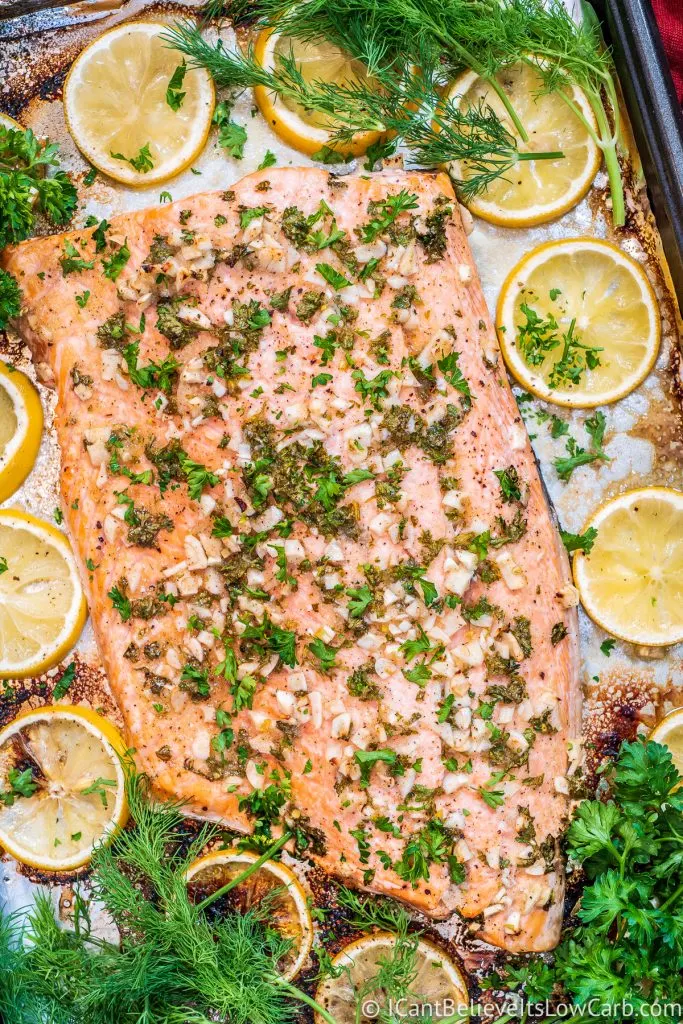
Did you ever go out to a fancy restaurant and decide that you were in the mood for some oven-baked salmon for dinner and then you took a look at the price and hedged about getting it?
In this recipe you will see how easy it is to make roasted salmon that is as good or better than you can get in a restaurant and for a lot less money. After all, why spend lots of money at a restaurant to have a delicious piece of fish when you can make it in a few minutes at home for a lot less money?
It is a super tasty and healthy meal to eat, so let’s see how you can cook salmon in the oven.
Is Baked Salmon Healthy?
Fish in general is a very healthy source of nutrients and salmon is no exception. In fact it is one of the healthiest fish that you can eat. There are so many health benefits of eating salmon. Here are a few:
- Rich in omega-3: reduces inflammation, and lowers blood pressure, and decreases risk of disease.
- Great source of protein: Protein is important for healing, your bones, and muscles.
- High in vitamins: Especially the B vitamins, B1, B2, B3, B5, B6, B9, B12 which are needed for energy production, controlling inflammation, and protecting your heart and brain.
- Good source of potassium: which helps control blood pressure.
- Loaded with selenium: A mineral that protects bone health improves thyroid function and reduces the risk of cancer.
- Contains the antioxidant astaxanthin: This is a benefit for the heart, brain, skin, and nervous system.
- May reduce the risk of heart disease: By increasing the levels of omega 3, and decreasing the levels of omega 6, lowering triglycerides.
- May benefit weight control: It may reduce appetite, boosting metabolic rate, increasing insulin sensitivity while decreasing belly fat.
- Can help fight inflammation: By reducing risk factors for several diseases.
- May protect brain health: May help reduce symptoms of anxiety and depression and aid in memory.
- Delicious and versatile: Can be prepared in various ways, can even be bought in a can which can be used in different recipes.
Various Ways to Bake Salmon

There are 3 main ways to cook your salmon in the oven and we will explain each of them to you.
Roasting (Baking) – The most popular way to cook salmon is by making oven-baked or roasted. It’s my favorite way, I love the way it tastes. Season it up and pop it in the oven and it cooks itself without any effort, it’s so easy.
Searing then Baking – This is another good way to prepare a piece of salmon, especially when the skin is on it because when you sear it the skin gets nice and crispy while the fish remains juicy. We have made it this way so many times and I love eating the crispy skin.
I like to sear it and then bake it the rest of the way until it’s done, but if you prefer you can just sear it and then continue to cook it in the frying pan.
Broiling – This is a quicker way than making baked salmon fillet, but if you don’t watch it carefully it can burn on the outside. You also have to flip it over in order to broil both sides.
What Ingredients are in Baked Salmon?
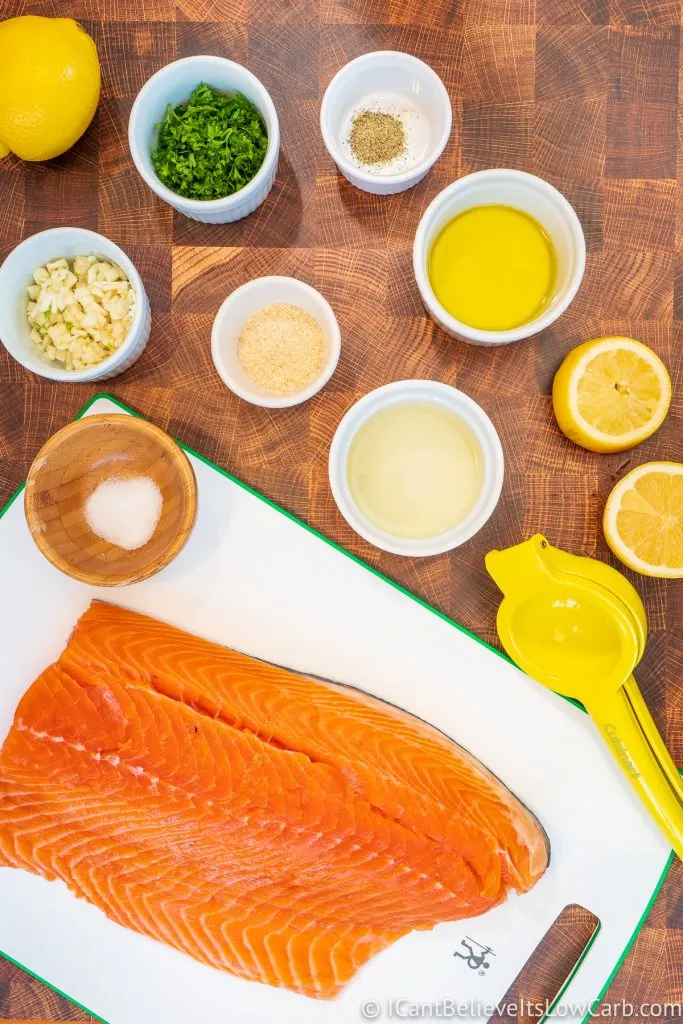
There are many ingredients that you can use when you make baked salmon in the oven and here are a few of our favorites:
- Salmon – Fresh, atlantic, wild, or farm raised.
- Olive Oil – Extra virgin.
- Lemon Juice – Fresh is best but bottled will do.
- Onion Powder – Is just enough to give the fish a mild onion flavor.
- Garlic – Fresh and chopped but jarred works too.
- Pepper – Black, fine or coarse.
- Salt – Any type of table salt, fine or coarse.
- Parsley – Fresh chopped is best but dried will work.
Seasoning Ideas
Sometimes it’s good just to use basic, simple spices to use on top of your salmon. Our favorites are salt, pepper, and garlic powder.
You can also add other ones such as onion powder, paprika, parsley, Italian seasoning, and the list goes on….whatever you like.
Salmon is so versatile that one time you can make it with certain flavors and the next time you can use others. Lemon is also a staple ingredient for fish, either lemon juice or lemon zest and it gives salmon a very fresh flavor.
Sauces
You don’t necessarily need a sauce on roasted salmon, but it does enhance the flavor. Here are a couple of ideas:
Garlic and Olive Oil Combo – A very common sauce to use on top of baked salmon that is easy to make and very flavorful. No matter how many times I try other things I always go back to making my salmon with a garlic and olive oil sauce.
Lemon Juice and Butter – A sauce made from lemon juice mixed with butter is also a good sauce to brush on top of your baked salmon, then sprinkle with salt, pepper, parsley…etc.
Cuts of Salmon
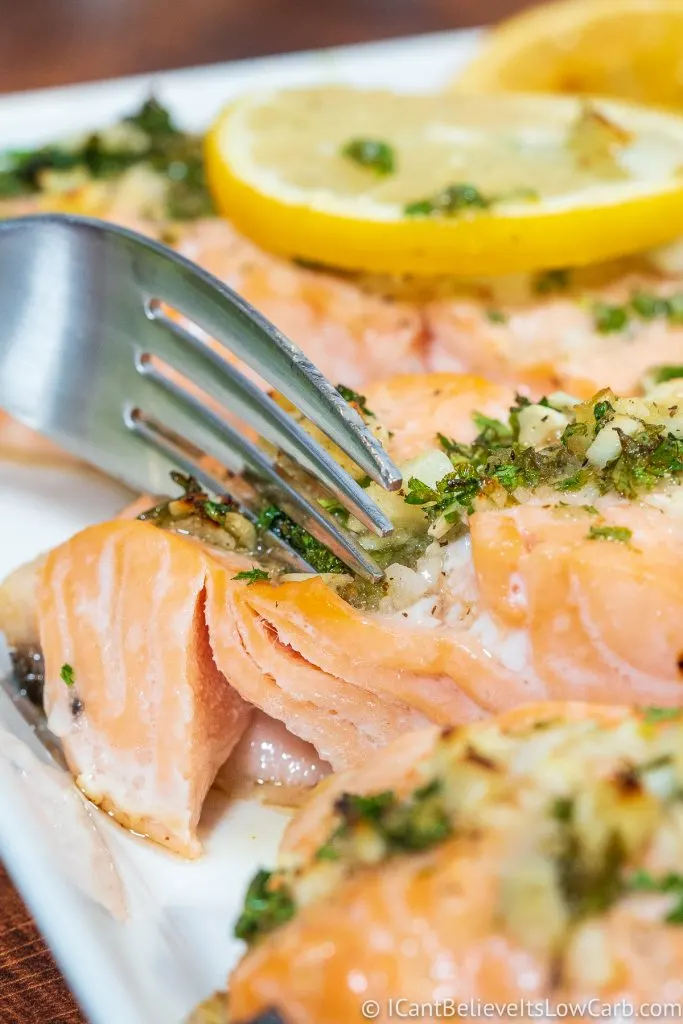
Salmon comes in a variety of sizes and cuts. Let’s take a look at some of the most common cuts:
- Thicker Fillet – fattier and takes longer to cook.
- Thinner fillet – cooks faster than a thicker cut.
- Whole fillet – cook the thinner piece less than the thicker piece.
- Small fillets and steaks – cook quickly for fast weeknight meals.
- Whole side of salmon – the size needed for a family dinner or dinner party.
Farmed vs Wild
There are significant differences between farmed and wild salmon.
Wild Salmon
- Mostly in the Pacific waters because industrial fishing has almost completely wiped it out in the Atlantic.
- Silky texture
- Superior taste
- Fewer calories
- Less fat than farmed salmon
- Less availability which causes a higher price
Farmed Salmon
- More plentiful which causes a lower price
- Comes from the atlantic
- Light pink flesh
- Environmental concerns surrounding farmed salmon
Whether you decide to buy a farmed or wild type, we will show you how to make the best baked salmon recipe in the world!
Wild Species
- King Salmon or Chinook – The largest and most succulent because it’s higher in fat than other varieties, and is very popular.
- Sockeye Salmon – Deep red flesh and a firm texture very popular and has less fat than other varieties.
- Coho or Silver Salmon – A milder tasting salmon.
- Pink Salmon – It is pale in color and very small compared to other varieties. You will most likely find this type of salmon in cans.
When is Wild Salmon in Season?
- Sockeye: May-September
- Copper River Sockeye: May-June
- Coho: June-September
- Pink: July-September
So as you can see these wild varieties are available only in the months of May-September, hence the reason that we buy farm-raised a lot since it is available year-round.
Farmed Salmon
Farmed salmon is not as good as wild salmon but it is available all year long in our grocery stores. It has a rich, but mild flavor and is more affordably priced than wild salmon.
Farmed salmon can be found in the Atlantic, the Pacific and also New Zealand.
Fresh vs Frozen?
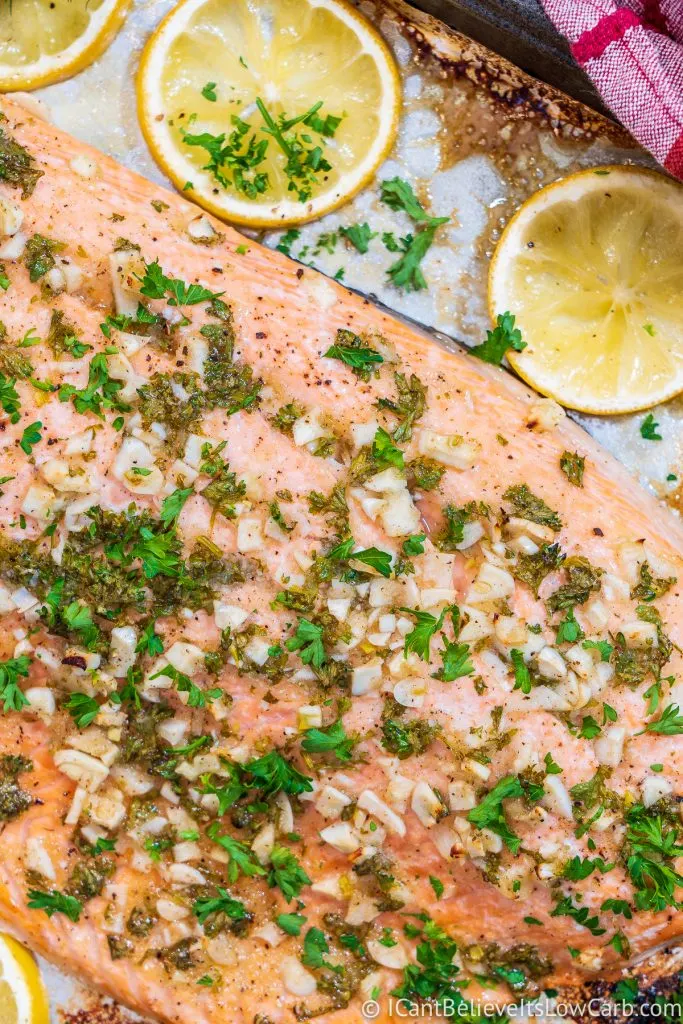
Just like all fish, fresh salmon is always better than frozen. The only problem is it might not always be available in your supermarket. In that case, frozen can be used too.
Frozen salmon is still good to eat, especially if you are craving it and you want to make some salmon dishes, but can’t find fresh in your store.
What to Look for When Buying Salmon
When you go to the store to pick out your salmon, wild caught is my first choice, but you can’t always find it in the store. You may have to buy farm raised, which I also do buy, but only when I really want to make a salmon recipe.
It’s important to look for salmon that has a bright silvery skin, and a shiny flesh that is moist and brightly colored. Avoid salmon that smells too fishy and it should smell more like saltwater.
Some people don’t like to eat the skin but it is still good to cook it with the skin because it will prevent the salmon from drying out while it’s cooking. You can eat around the skin or remove it from the flesh after the salmon is done roasting.
Why is it So Expensive?
Salmon is more expensive than other types of protein because there is more work involved in the steps involved in bringing it to your table.
- If you are eating wild salmon, the fish has to be caught in the wild by fishermen which increases the price.
- Salmon are also susceptible to disease because of salmon farms, whose waste pollutes the oceans where salmon live.
- Another reason salmon is expensive is because there is a huge demand for it. At one time it was a delicacy which was only eaten on special occasions or when a person would go out to eat but now everyone wants to buy salmon and eat it on a regular basis.
If you are like me, shop at Costco and you can get a very large piece of fresh salmon for yourself for not too much money.
Since it is a fresh fish, not previously frozen, I like to buy a really big piece and cut it up into individual-sized portions and stick it in the freezer to make baked salmon fillets for other future meals.
Different Variations of This Recipe
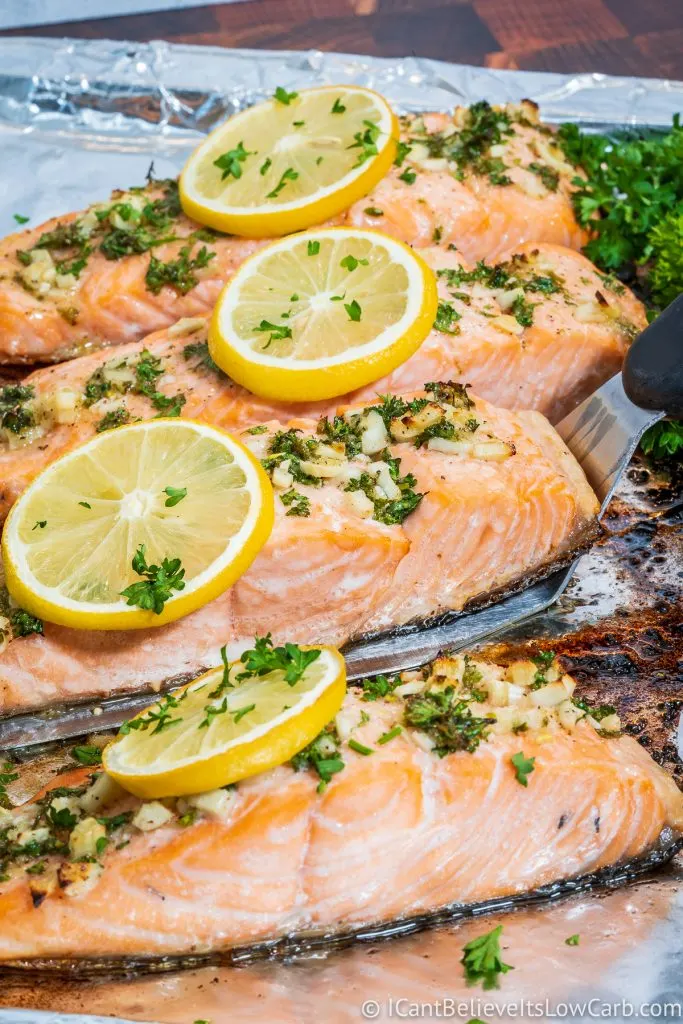
Salmon goes with many other flavors. Our recipe is a guide but you can modify it to your taste.
Here are a few ideas of variations when making baked salmon recipes:
- Lemon Dill
- Cajun
- Pesto
- Lemon Rosemary
- Garlic/Butter
Tools to Use
You will need a few easy tools to make the best baked salmon recipe:
- Baking sheet or tray – used to cook the fish in.
- Brush – to spread the butter or olive oil sauce on the salmon.
- Thermometer – to check the temperature of the salmon to see if it is undercooked or ready to take out of the oven. A thermometer is the best tool to ensure the right temperature when making roasted salmon.
- Spatula – it is used to remove the salmon from the baking sheet, which will also help to separate the fish from the skin after the baked salmon is done cooking if you do not want to eat the skin.
Salmon Cooking Temperature
If you are making baked salmon in the oven, I prefer to cook it at a high temperature, preferably 425-450 degrees. This depends on your oven which can vary slightly.
- High Temperature – When you are cooking salmon on a high temperature it cooks quickly and has a baked/roasted texture on the outside and soft and juicy on the inside.
- Low Temperature – If you cook it on a low temperature it takes longer and has the same texture throughout, which is doable but I prefer the high temperature quickly.
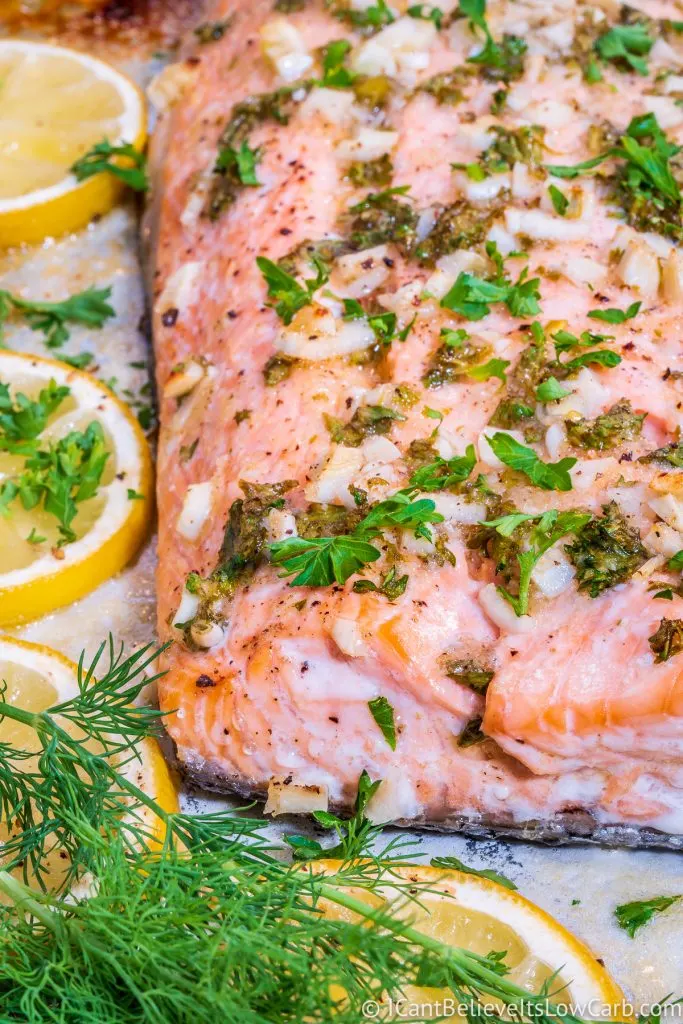
How Long to Bake Salmon in the Oven?
When making oven-baked salmon, the size and thickness of the salmon will establish how long to bake it in the oven. Also the temperature of the oven can vary from other ovens.
As a rule of thumb, the best temperature for baked salmon in the oven is 425-450 degrees.
Here is a small chart that you can use as a guide to make the best baked salmon (at 425-450 degrees):
- Rare: cook for about 7 minutes.
- Medium rare: cook for about 9 minutes.
- Medium: cook for about 11 minutes.
- Medium well/well: cook for about 13 minutes and above.
How to Tell When Salmon is Done Cooking?
When to take the salmon out of the oven will depend on how you like it cooked, just like when you are eating a steak. Some people like it rare, medium or well done, and salmon is no different.
I personally do not like it rare, I like it more like medium on the inside and more crusty on the outside, especially the skin on the underside. To me that is important in order to make a good baked salmon fillet.

One thing to be careful of when cooking salmon in the oven is if it’s too rare, you always have the chance of bacteria setting in and causing sickness due to the bacteria that only goes away when the fish is cooked enough.
So if you have a more sensitive digestion then cook the salmon thoroughly so that you can still make it a healthy meal.
When you look at the inside of your salmon that is cooking in the oven, it is rare when the color is deep red on the inside and light pink around the outer edges, just like a rare steak.
To be sure that the salmon is done, a thermometer will be your best guide in letting you know the internal temperature.
Even though you want to be careful, the biggest mistake you can make if you are trying to prepare the “best baked salmon in the world” is to overcook it. If you undercook it, you can at least put it back in the oven and bake it a little longer.
Internal Temperature
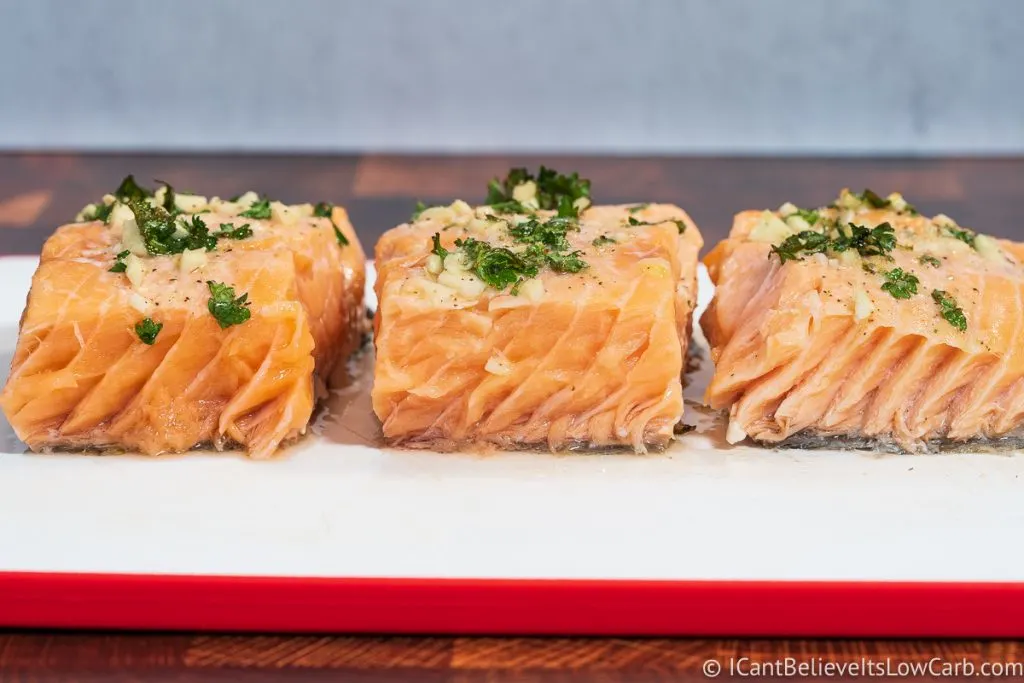
In order to cook salmon to your desired doneness, you need to know the internal temperature of the fish.
Here is a guide to help you:
- Rare – take it out at 110 degrees
- Medium – take it out at 120 degrees
- Medium Well – take it out at 130 degrees
- Well Done – take it out at 140 degrees
Checking for Doneness
The only way that you can be sure that salmon is cooked just the way that you like it is to use a thermometer. That way there is no guessing game involved that way and you use it like you would if you were making your favorite roast beef, pork roast, steak….etc.
There are 2 types to consider:
- Dual-probe wireless thermometer which can be used inside a hot oven and will cost around $25
- Instant-read thermometer which can not be used inside the oven and will cost you around $10
The best way is to use a cooking thermometer that will give you an instant read. They are easy to use and not expensive.
Cook with Skin?
You can do it either way, but it’s better to cook the salmon with the skin on, because it will keep it from drying out while it is cooking.
Once it’s done cooking and you are ready to eat, if you don’t like the skin you can eat around it or even take it off completely using a spatula to remove it.

Do You Bake Salmon Skin Up or Down?
If you cook salmon with the skin left on it, then the proper way to bake it is to put the skin side down. The skin is more durable than the flesh and should be used as the base.
Can You Eat the Skin?
Yes! Crispy salmon skin is not only delicious, it’s healthy, too.
Salmon skin contains high amounts of heart-healthy omega 3 fatty acids, so feel free to eat the skin. If salmon skin is not crispy though, it is not very appetizing.
Sometimes it is referred to as salmon bacon because it comes out so crispy. That’s what I call healthy bacon!!!
To make the skin crispy, after the salmon is cooked, remove it from the baking sheet by sliding a spatula between the skin and the flesh. This will leave the salmon skin on the baking sheet.
Now put the baking sheet back into the oven and turn the oven off. The leftover heat from the oven will crisp up the salmon skin.
Thawing Salmon Properly
If you buy a piece of frozen salmon or you buy it fresh and then freeze it, you need to thaw it out properly. If you do, then it will be just as if you ran out to the market and bought a fresh salmon fillet.
There are 2 ways to properly thaw salmon:
- Take it out of the freezer and thaw it out slowly in the refrigerator overnight.
- Place it in a sealed ziploc bag and run it under cold water until it thaws out.
Do You Have to Wash Salmon Before Cooking It?
Your fresh fillets do not need to be rinsed off, but you may want to if you are worried about possible bacteria. Salmon and all other fish slowly break down because of enzymes and bacteria. Spoilage and odor-causing bacteria are still present, mostly on the surface of the fish.
If fish has a fishy odor, you are smelling compounds that are created as bacteria. Rinsing fish in clean, cold freshwater will remove much of the surface bacteria and will reduce offensive fishy smell. That fishy smell intensifies when cooked.
- Use a gentle flow of cold water because if the water is too hard it will make the bacteria splash around the sink. The same is true when rinsing raw chicken. Rinsing does remove the surface bacteria from salmon or chicken.
- Do not use soap, even though it is more effective at removing surface bacteria, it will affect the flavor of the fish.
- After rinsing off the salmon, pat it down with paper towels to ensure that it’s not wet, or else the oil will not stick to the fish.
TIP: If the salmon still has a fishy odor after rinsing it in cold water, use a little lemon juice which will kill the odor. Use only a small amount or else it will be too much and overpower the fish.
Removing the Pin Bones
Why Do It? – Salmon fillets sometimes have small pin bones, about 1 inch long, that stick up in the center of the fish. There could be as many as 20 of these bones in a whole fillet, or there could be none.
Even if the fish has been deboned before you bought it, sometimes there could be few small bones that have been left behind so be proactive and make sure to remove any.
To Remove Bones:
- Before baking, lay your salmon fillet flat on a board or on a sheet of foil on your counter, skin side down (even if there is no skin).
- Gently run your fingers across the surface of the fish. You will feel a ridge of the tiny bones sticking up.
- If you see bones, start at the thickest end of the fillet, use needle-nose pliers or tweezers to grab the tip of the bone and firmly yank it out.
Cutting Salmon
Salmon can be baked in the oven either whole in one big fillet, or cut into smaller filets. Either way is perfectly fine.
When you go to the store you can buy a large piece of salmon, weighing as much as 2 pounds or more, or you can also buy individual fillet pieces of salmon, which have been cut from a large piece.
If I have a choice, I will buy a large piece of salmon and either cook it whole or cut it into fillets. Usually buying a whole big fillet is cheaper than buying pre cut, individual portion sized fillets.
If I am not going to use the whole piece, I will cut it up and freeze the rest.
Cutting Salmon:
- To cut it, use a large cutting board and a sharp knife.
- With one hand on the salmon and the other one holding the knife, decide how big that you want your fillets to be and cut the pieces crosswise completely through and pull it away from the uncut part of the salmon.
Seasoning Salmon
The most fun part about making baked salmon or any other salmon dish, is seasoning it. You can make it simple with just a few things or more spices if you choose.

You can make one baked salmon recipe today and another the next time.
For this oven-baked salmon recipe we chose to use these spices:
- Garlic
- Onion Powder
- Salt
- Pepper
- Parsley
- Lemon Juice
Here’s what to do:
STEP 1: To season the salmon, first mix all of the spices in a bowl with olive oil, and blend them all together well.
STEP 2: Dry the salmon with a paper towel so the spices stick to it better.
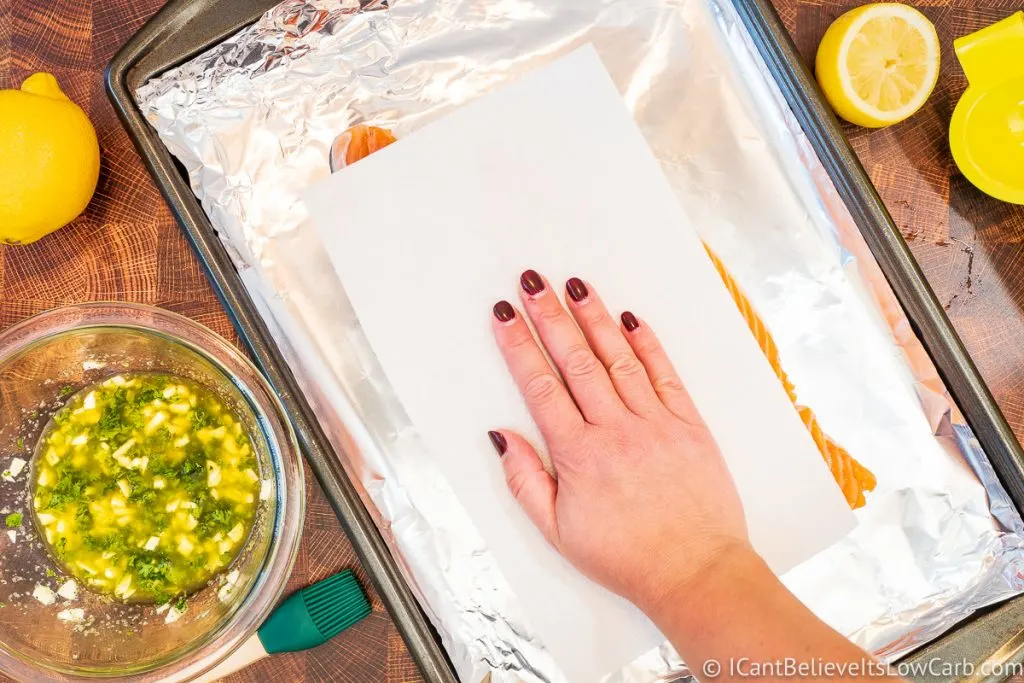
STEP 3: With a brush, cover the salmon with the spiced oil well.
Now that you have seasoned it, you are ready to cook your salmon.
3 Ways to Bake Salmon in the Oven
The 3 ways to cook salmon are:
- Baking/Roasting
- Broiling
- Searing then Roasting
How to Make Baked Salmon in the Oven
The first way is to make oven-baked salmon. Let’s see how to make it step by step…
Why Do It? – Baking is an easy and healthy way to do it. You can season it and pop it into the oven. That’s it. The baked salmon comes out tender. When you bake the salmon in the oven there is less smell in the kitchen than if you fry it.
How to Do It?
- Preheat the oven to 425 degrees.
- Mix the oil, lemon, and spices to coat the salmon (see above instructions).
- Place your salmon skin down on top of a baking tray that is prepared with a piece of aluminum foil or parchment paper.
- Dry off the flesh part of the salmon with a paper towel because if it is too wet, the oil mixture will slide right off the top of the fish and onto the tray.
- Generously apply the oil mixture, some will run off the top and onto the tray which is ok but at the same time, you want a good portion of it to stay on top of the salmon.
How Long to Cook? – Place the tray in the oven and bake at 425-450 degrees, for 10-12 minutes, depending on how well done that you want your baked salmon to be. When you stick a fork in it, you will be able to see the salmon flake.
Do I Have to Cover It with Foil? – No, do not cover the salmon or it will not get roasted properly and will be more like boiled.
How to Broil Salmon in the Oven
Why Do It? – By broiling something in the oven, it cooks quicker and gives it the crispier effect.
Broiling the salmon will make it crusty on the outside and soft on the inside. Place the salmon skin side down on the tray. It is not necessary to turn the salmon over, to broil both sides. The heat under the broiler will cook it thru.
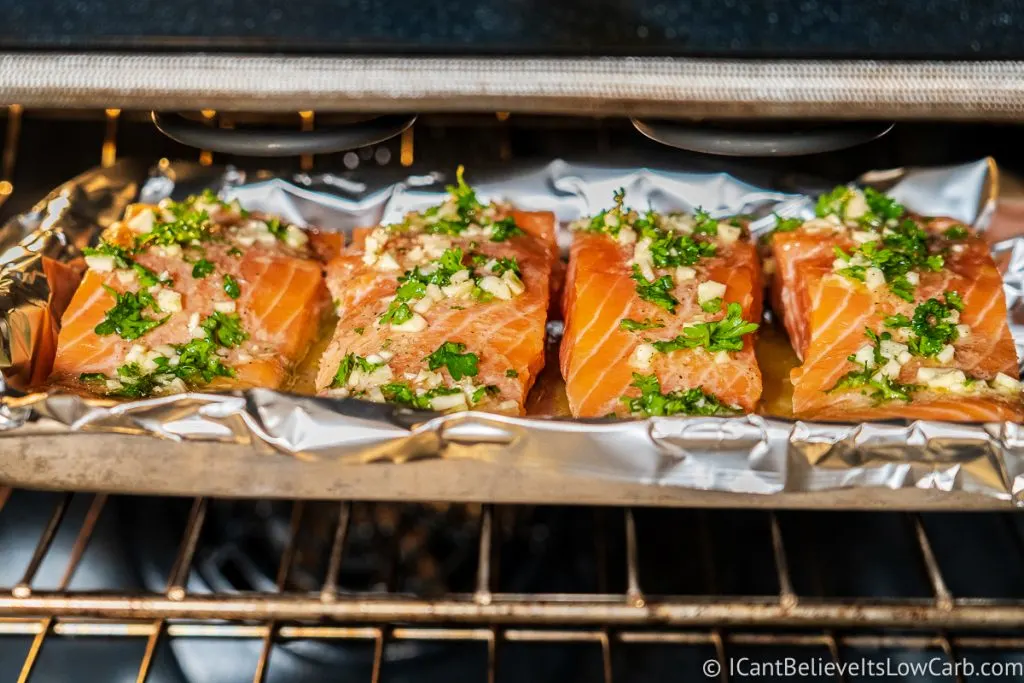
How to Do It
- Use a baking sheet, baking dish or cedar plank to broil the salmon on. (If you use a cedar plank, soak it in water before using it to protect it.)
- If you use a baking sheet, coat it with oil or line it with foil so that it doesn’t stick to the pan.
- Place the salmon on the baking sheet skin down.
- Season the fish with the oil, lemon and garlic mixture or other desired seasonings (see above section for instructions).
- Place the salmon in the oven on the top rack and broil on a high temperature.
How Long to Cook? – Usually, about 3-5 minutes under the broiler is enough to properly cook it but by using a thermometer you will be able to test it for doneness.
TIP: Be careful not to burn the salmon by leaving it under the broiler too long.
How to Sear then Roast Salmon
Why Do It? -When you sear something, first it seals in the juices. It will be crispy on the outside and softer on the inside.
This is especially important to me because when you sear it, the skin becomes crispy and flavorful just like chicken skin gets crispy on baked chicken. This is the key to making the best salmon recipe!
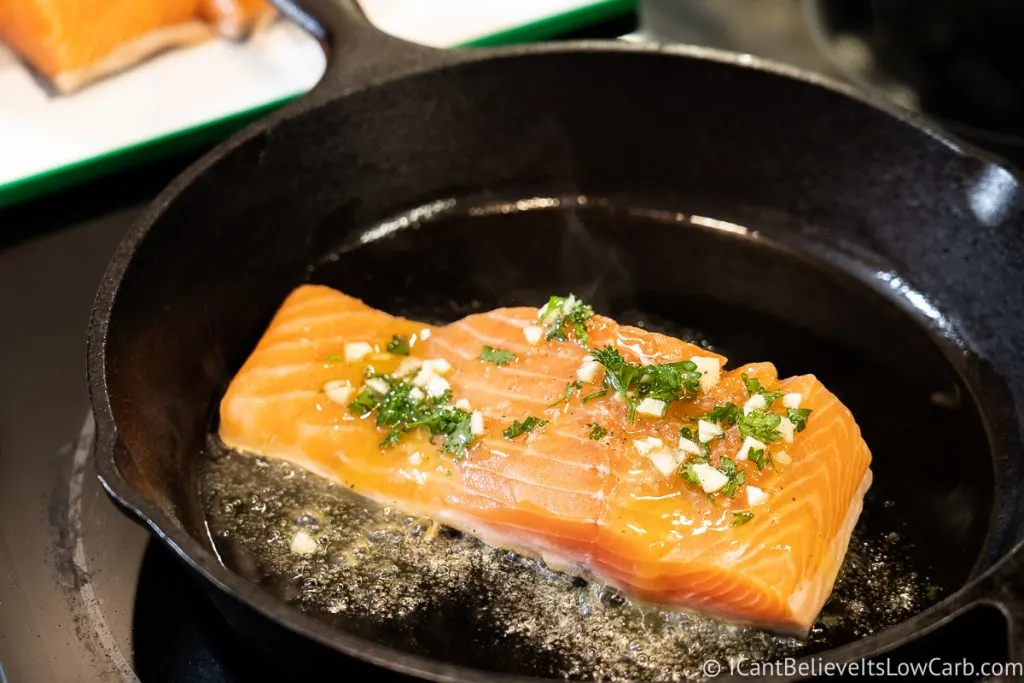
How to Do It? – Sear the salmon on the stove top and then finish it in the oven or under the broiler. You can also sear it completely on the stove using this as your only cooking method.
For this recipe we are going to sear the salmon in a non-stick or cast iron pan, and then move it to the oven in the same pan to finish cooking.
- Mix the oil, lemon and spices to coat the salmon. (See above section for instructions)
- Coat the fish with the oil, lemon and spices mixture on a baking sheet or flat surface.
- Preheat the oven to 425 degrees.
- Get your cast iron frying pan or dutch oven and turn the heat on medium high.
- Add some butter or olive oil to the pan, about 2 Tbsp is a good amount.
- When hot, add the salmon that has already been seasoned. Place the fish flesh side down, and skin side up. You do not need to flip the salmon over because the skin will crisp while baking. Do not crowd the pan and do not move the fish.
- Flash fry it 3-4 minutes until a golden brown crust starts to form on the bottom side of the fish on medium high heat which will trap in the juices.
- Now move the pan from the stove into the oven to finish cooking.
How Long to Cook? – It doesn’t take too long to roast the salmon in the oven, usually 4-5 minutes at 425 degrees depending on how rare or well done that you like your fish, also depending on how thick the fish is.
Best Tips for Oven-Baked Salmon
- Be sure to check for bones before cooking your salmon.
- When baking or broiling the salmon, use a piece of aluminum foil or parchment paper on the baking sheet to prevent the fish from sticking to the pan.
- If you want tender salmon, then cook it with the skin on. This would apply whether you are baking, broiling, or searing your salmon.
- When cooking salmon, put the skin side down.
- Be sure to use a thermometer to ensure that you do not overcook your salmon.
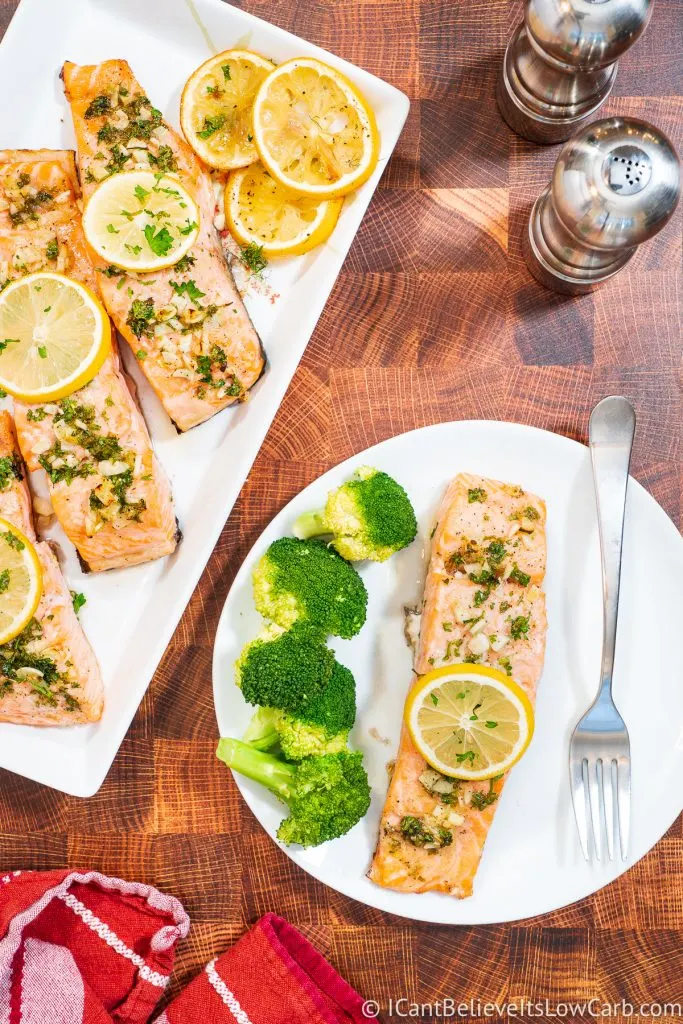
Don’t Overcook It
Possibly the worst thing you can do to your oven baked salmon is over cook it, because it will be dry instead of juicy.
To prevent that from happening, the best thing to do is to remove the salmon from the oven shortly before it’s done. While it rests on top of the stove or on the counter, it will continue to cook further.
As a rule of thumb with any meat or fish, if it comes out of the oven and it is not cooked enough you can always put it back in the oven, but if it’s over overcooked there is no going back….now it’s ruined.
Should I Bake Salmon in Foil?
You may be wondering if you should use foil while baking your salmon? While it’s not absolutely necessary to do, let’s look at some reasons why you should use foil.
- The foil locks in moisture and ensures that your beautiful piece of salmon turns out flakey, moist, and tender every single time.
- Foil acts as a flavor incubator. Whatever ingredients you place with the fish in the foil will flavor every single bite of your oven-roasted salmon.
Just a side thought, if you don’t want to bake the salmon with foil, you can make baked salmon on parchment paper instead!
TIP: When grilling your salmon in your backyard, the foil is good to wrap around the fish so that it will cook evenly and not burn.
What Is that White Stuff That Comes Out of Salmon?
The white stuff on salmon is called albumin, which is a protein that exists in the fish in liquid form when it’s raw, but it then coagulates and becomes semi-solid when your salmon is cooked. This happens whether cooking it in the oven, on the stove, or on the grill.
As the meat cooks, the albumin gets squeezed out and looks like a weird, slimy, white substance but no worries, it is safe to eat.
Can You Eat the Grey Part of Salmon?
When cooking salmon it can develop a gray-brown layer of insulating fat between their skin and flesh. Yes, it’s okay to eat it, though some people dislike the flavor. I personally don’t think it has a different flavor than the skin.
Like the fat deposited within the flesh, this gray layer contains heart-healthy omega-3 fatty acids.
However, the fat in farmed salmon may also contain elevated levels of PCBs and other industrial pollutants, depending on where the fish comes from and what it was fed.
It’s entirely up to you whether you want to eat it or not, but in order to remove it you need to also remove the outer skin.
Should I Bake Salmon Covered or Uncovered?
One of the main questions you may ask while learning how to cook salmon in the oven is “Should I bake it covered or uncovered?”
It is a good question, and in order to make the best baked salmon recipe, baking it uncovered will achieve a roasted texture and taste.
If you cover it then it will end up coming out steamed or poached instead of baked.
Baking vs. Frying
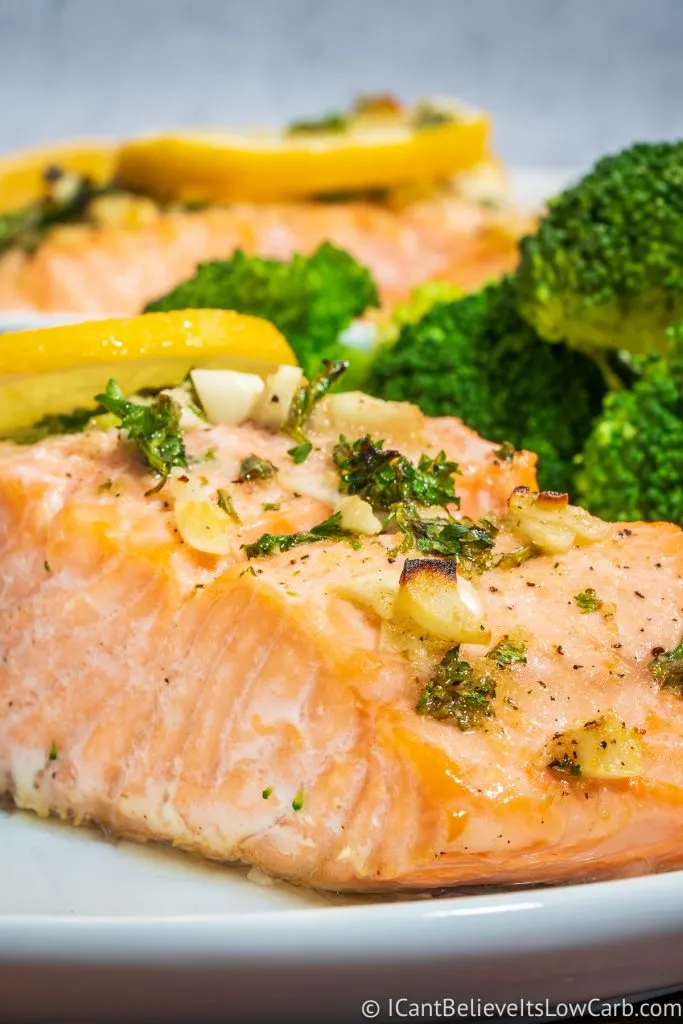
Let’s look at some of the differences between baking salmon or frying it:
Baking: Baking something is always healthier than frying. Also baking salmon in the oven rather than frying it on the stove will leave less odor in the kitchen.
Baking salmon is a really good way to make a large quantity of fish rather than just a piece or two. Compared to frying, it’s easier to put it all in the oven.
If you have many salmon fillets or a huge whole salmon piece, then it is best in the oven because once you put it in the oven it does not require constant attention.
Frying: This is a quick way to cook salmon in spite of the smell of fried food in the kitchen. Also, who doesn’t like the flavor that frying something gives you?!
It is easy to do and a fast way to cook salmon fillets, making it a quick dinner option after working all day. It is a good way to make 1 or 2 pieces of salmon but it will require you to stand at the stove the whole time while cooking.
One good thing about frying something rather than baking it, on a hot summer day when you use your stove top instead of the oven it cuts down on the excessive heat in the kitchen.
Here are some quick instructions for frying salmon:
- Using a large, non-stick frying pan, cast iron pan, or dutch oven, add 2 Tbsp olive oil to the pan then preheat it on medium-high for 2-3 minutes until a couple of drops of water sizzle and bead up when you sprinkle it in the pan.
- Add the salmon fillet that has already been seasoned, skin side up first. Do not crowd the pan.
- Fry on the flesh side for approx 4 minutes, then flip over, skin side down, and fry for another 3-4 minutes until the fish looks like it’s starting to flake. The timing will depend on how thick your fish is and how you like it cooked, rare to well done.
- Remove the salmon from the pan carefully with a pair of tongs or a spatula.
TIP: Make more than just enough for one meal so you can leftovers the next day!!
What to Serve with This Recipe?
Two of my favorite things to serve with salmon are roasted potatoes or rice. If you can’t eat those then there are many vegetables that also go great with salmon.
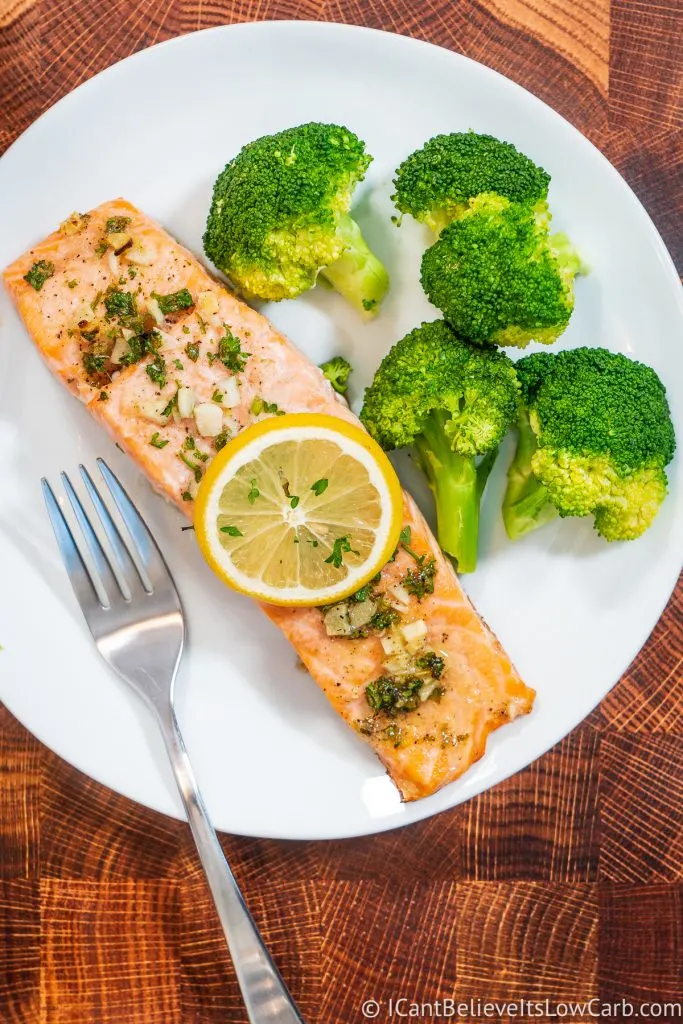
Here is a list of some of my favorite sides to serve with baked salmon:
- Asparagus
- Roasted Broccoli
- Roasted Brussel Sprouts
- Cauliflower Rice
- Roasted Green Beans
- Green Salad
- Butternut Squash
- Potatoes
- Rice
- Spaghetti Squash
- Creamed Spinach
How to Store Salmon
If you have leftover baked salmon, you can store it in the refrigerator and it will stay fresh for about 3 days.
Wrap it up properly in an airtight plastic container to preserve the freshness. It will be just as good the next day as long as you wrap it properly.
How to Reheat
To reheat your baked salmon just pop it in the oven on a low temperature, about 300-325 degrees for about 10 minutes.
You can also reheat it in the microwave, covered lightly with a paper towel for just a minute or two and it will be nice and hot.
Can You Freeze Salmon?
Yes you can freeze salmon, cooked or raw, I have done it several times. Just be sure to wrap it properly so that it doesn’t get freezer burn. If wrapped properly the salmon can last 3-4 months in the freezer.
TIP: I just started using plastic coated freezer paper to wrap my meats and other foods including salmon which helps protect them. It allows you to write what it is and the date you put it in the freezer which will help you keep track better.
When you are ready to cook it, just thaw it out slowly overnight in the refrigerator.
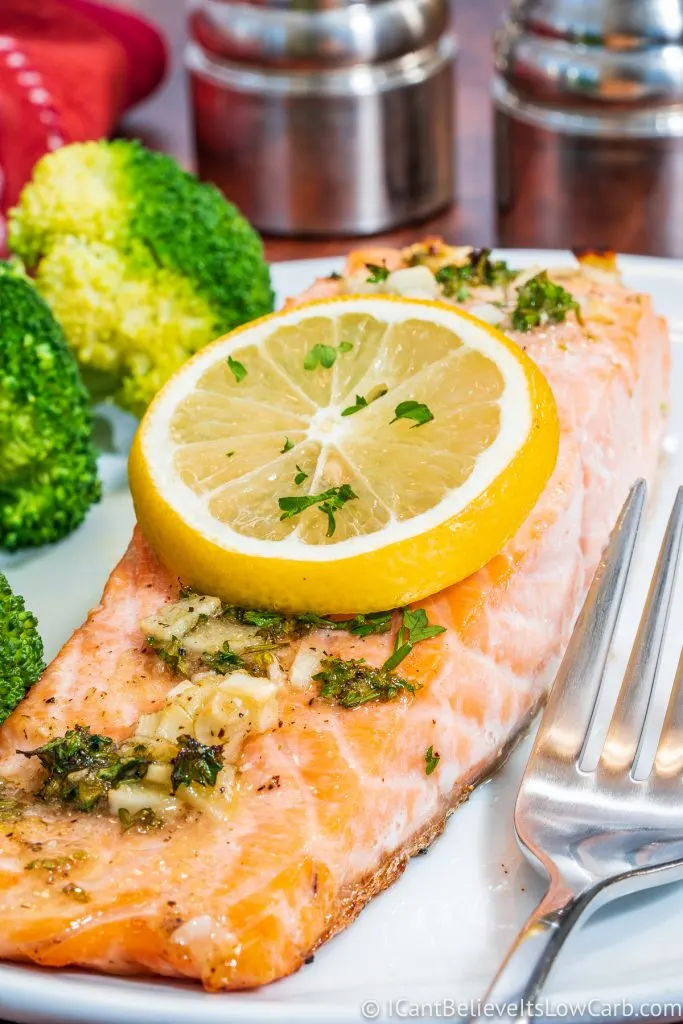
Try Our Other Delicious Recipes
If you’re looking for some other baked dinner recipes, check out our:
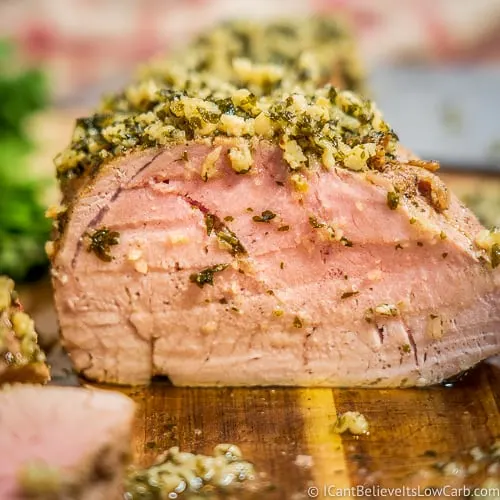
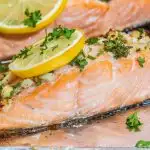
Best Baked Salmon | How to Cook Salmon in the Oven
- Total Time: 25 minutes
- Yield: 6 Servings (5oz. Per Serving) 1x
Description
In this baked salmon recipe, you will see how easy it is to make in the oven. As good or even better than you can get at a restaurant for less money. Add a few spices and turn this healthy salmon dish into a gourmet meal in just a few minutes.
Ingredients
- 2 pounds Salmon (1 Large Fillet or Smaller individual fillets)
- 1 tsp Onion Powder
- 4 Tbsp Olive Oil
- 4 Tbsp Lemon Juice
- 9 tsp chopped Garlic
- ¼ tsp Black Pepper
- ½ tsp Salt
- 3 Tbsp Parsley, chopped, fresh
Instructions
BAKED:
- Preheat the oven to 425 degrees.
- Mix the oil, lemon, and spices to coat the salmon.
- Place your salmon skin down on top of a baking tray that is prepared with a piece of aluminum foil or parchment paper.
- Dry off the flesh part of the salmon with a paper towel.
- Generously apply the oil mixture, some will run off the top and onto the tray which is ok but at the same time, you want a good portion of it to stay on top of the salmon.
- Place the tray in the oven and bake for 10-12 minutes, depending on how well done that you want your baked salmon to be. When you stick a fork in it, you will be able to see the salmon flake.
BROILED:
- Mix the oil, lemon, and spices to coat the salmon.
- Use a baking sheet, baking dish, or cedar plank to broil the salmon on. If you use a baking sheet, coat it with oil or line it with foil so that it doesn’t stick to the pan.
- Place the salmon on the baking sheet skin down.
- Season the fish with the oil, lemon, and garlic mixture or other desired seasonings
- Place the salmon in the oven on the top rack and broil at a high temperature.
- Usually, about 3-5 minutes under the broiler is enough to properly cook it. Check for doneness with a thermometer. so that you don’t overcook or burn the salmon.
SEARED THEN ROASTED:
- Mix the oil, lemon, and spices to coat the salmon.
- Coat the fish with the oil, lemon, and spices mixture on a baking sheet or flat surface.
- Get a cast-iron frying pan or dutch oven and turn the heat on medium-high.
- Add some butter or olive oil to the pan, about 2 Tbsp is a good amount.
- When hot, add the salmon that has already been seasoned.
- Place the salmon flesh side down, and skin side up. Do not crowd the pan and do not move the fish.
- Flash fry for approx 4 minutes until a golden-brown crust starts to form on the bottom side of the fish on medium-high heat which will trap in the juices.
- Remove the cast iron pan from the stove and stick it right in the oven to finish cooking. You do not need to flip the salmon over because the skin will crisp while baking.
- Bake it at 425 degrees for about 4-5 minutes or so, until the salmon reaches the desired doneness, which will depend on how thick the fish is.
Notes
Use parchment paper under the salmon to make sure that it doesn’t stick to the pan.
Check for small bones before cooking.
Leave the skin on and cook with the skin side down.
Use a thermometer so that the fish doesn’t overcook.
Be sure to cook extra salmon to have the next day or you can freeze it for another time.
Use plastic-coated freezer paper to wrap the salmon in so that it will protect it better and you can write the date etc on it. Then stick the wrapped fish in a plastic ziploc bag for added protection.
- Prep Time: 10 minutes
- Cook Time: 15 minutes
- Category: Main Courses
- Method: Baking
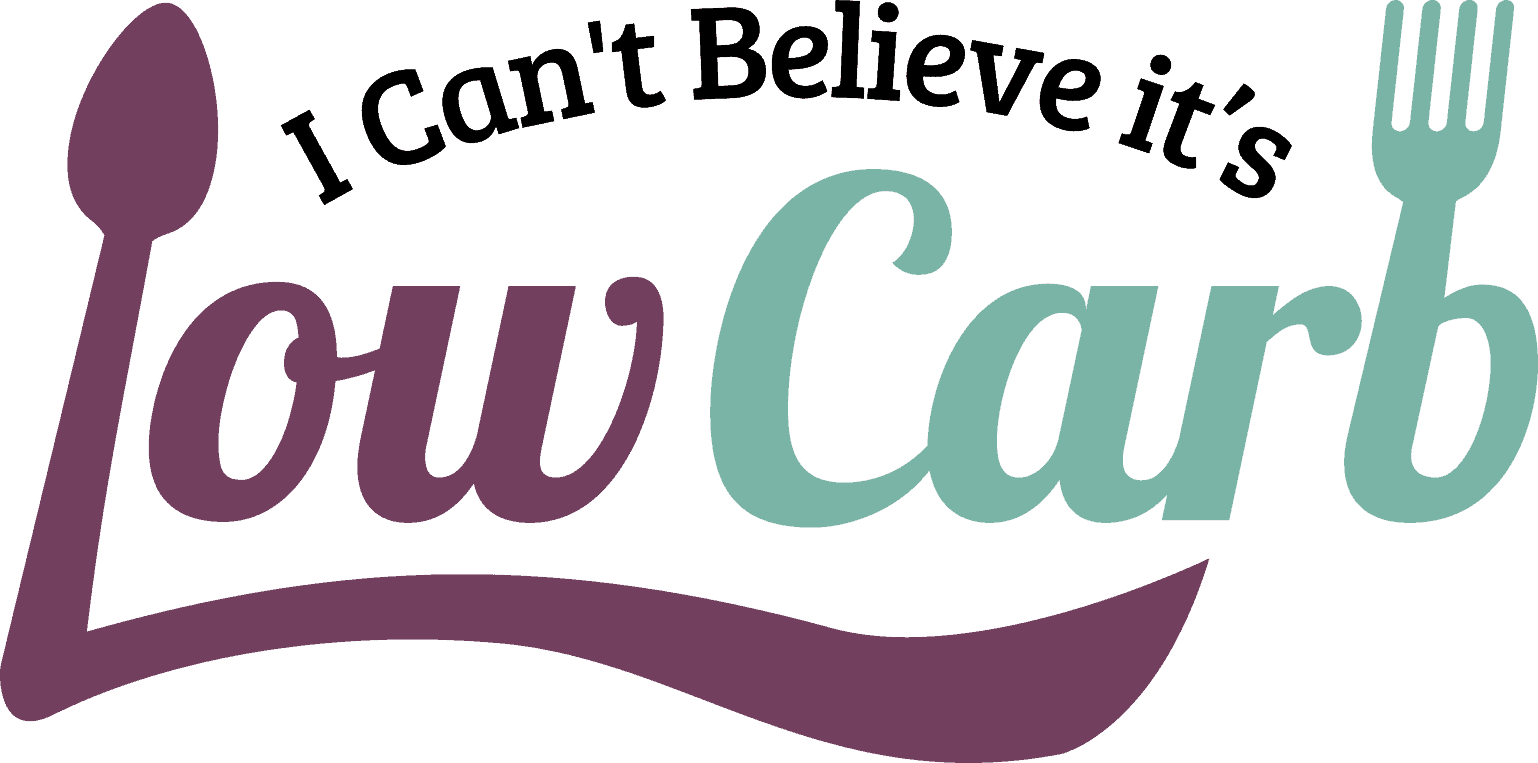
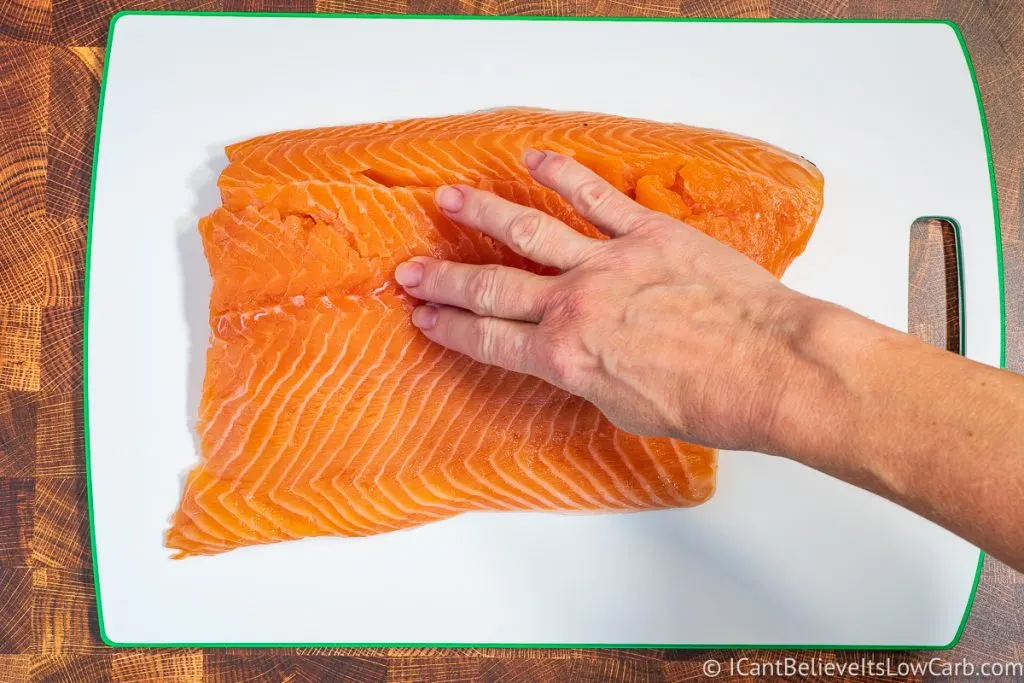
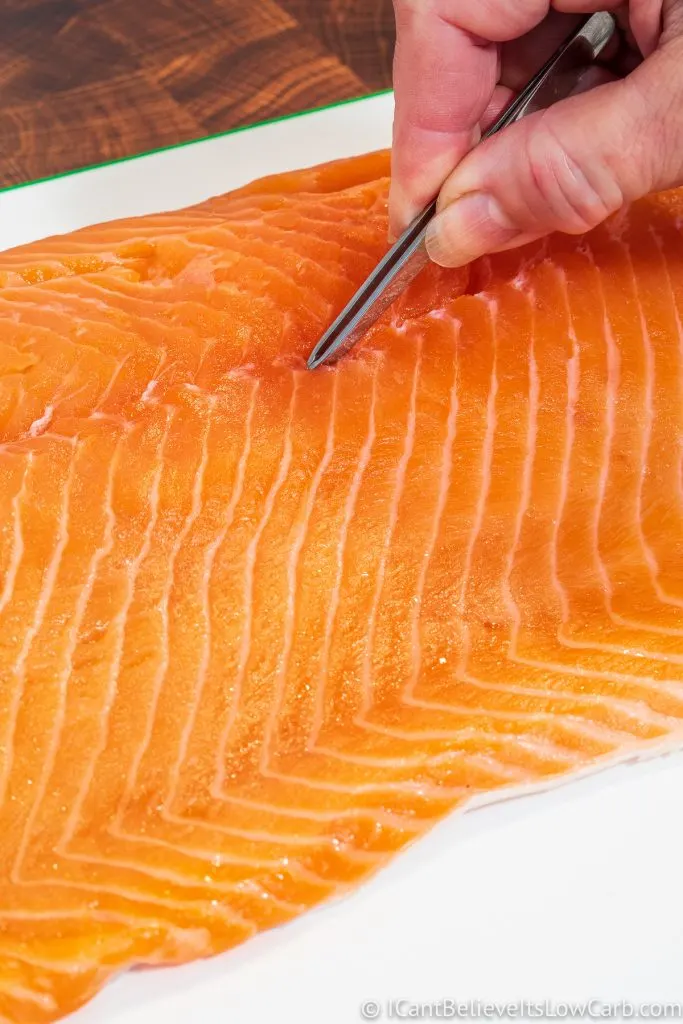
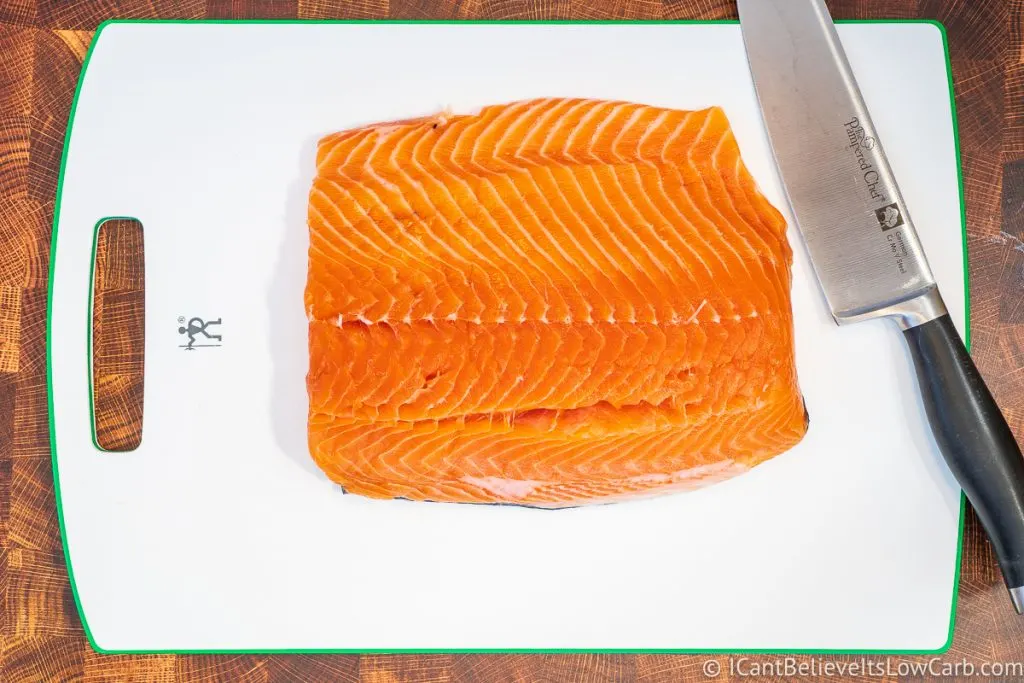
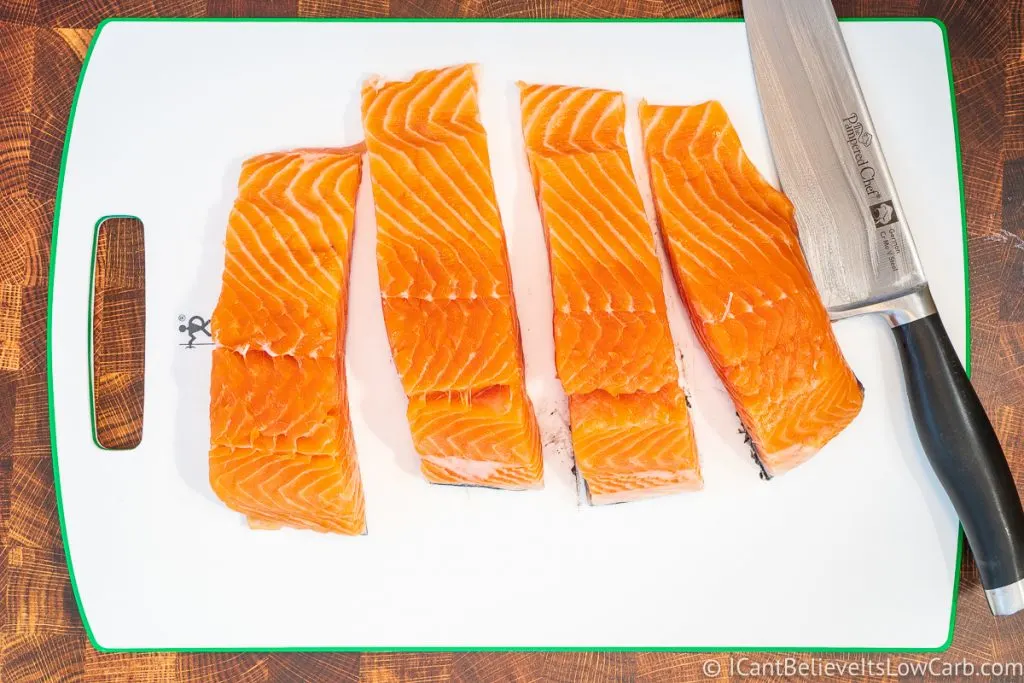
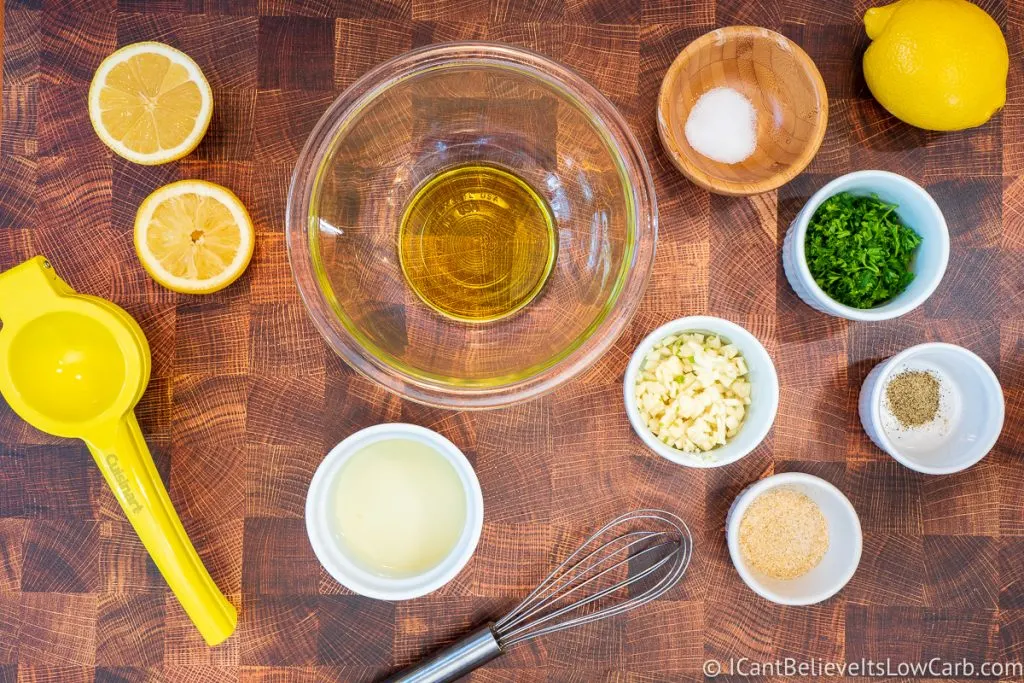
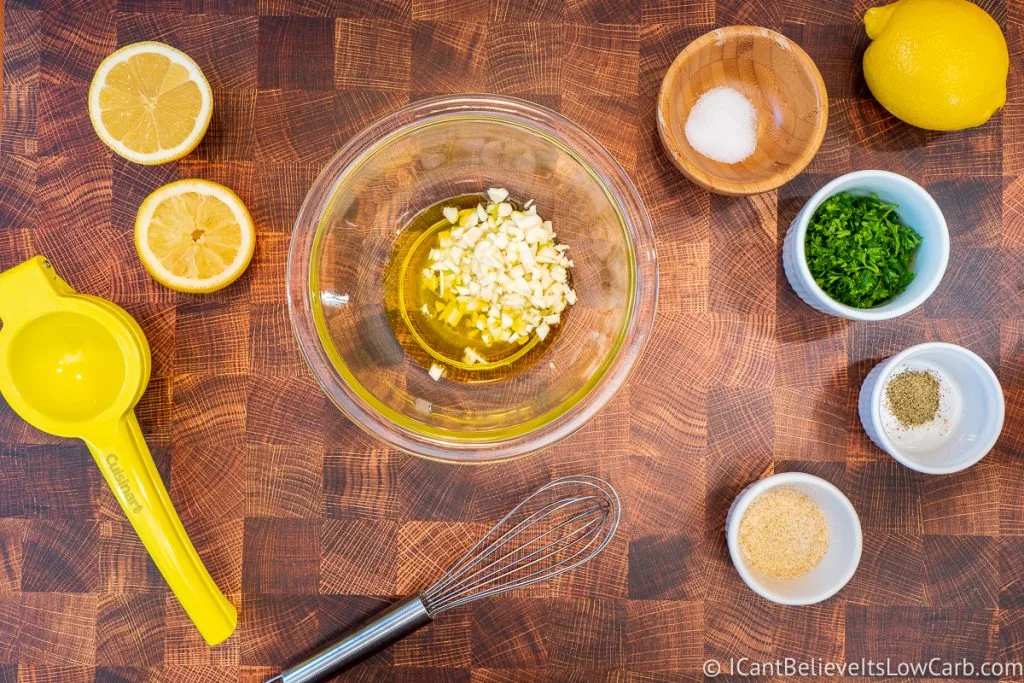
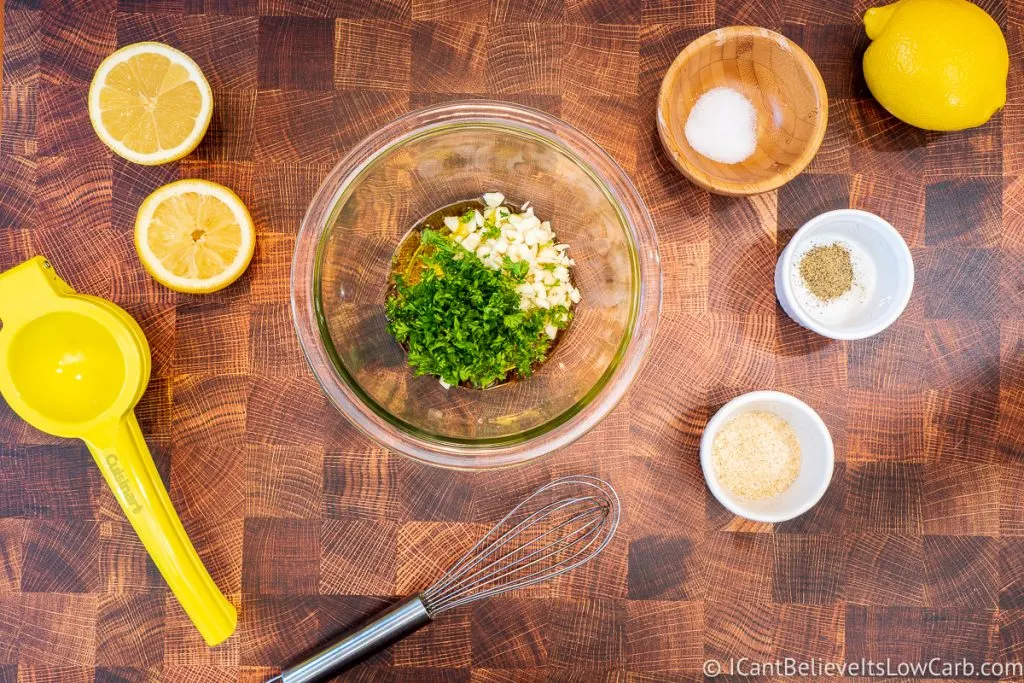
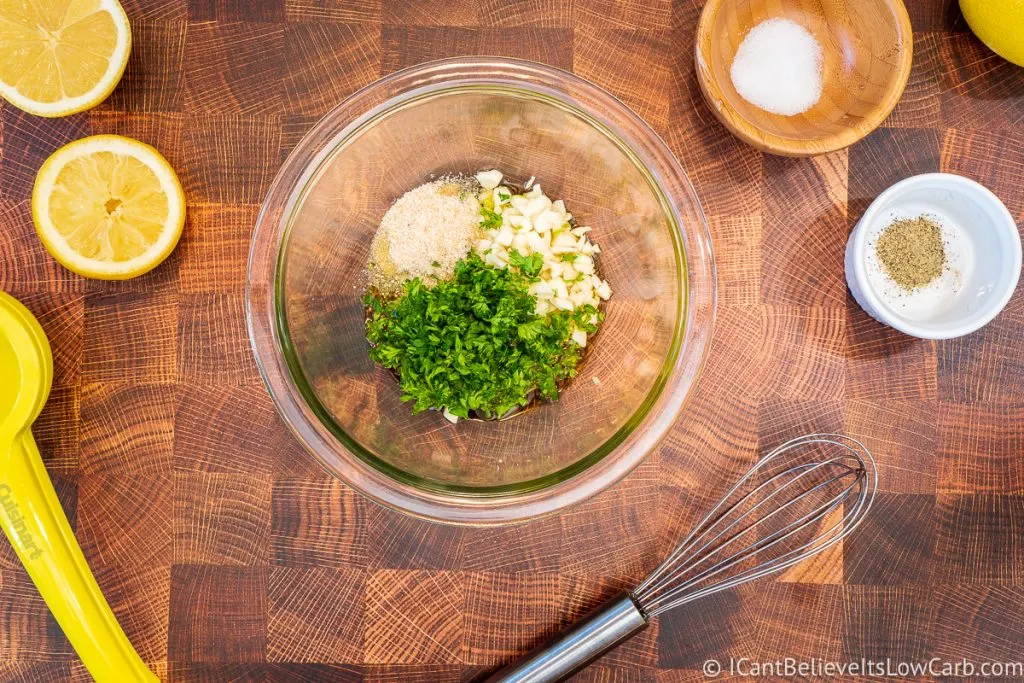
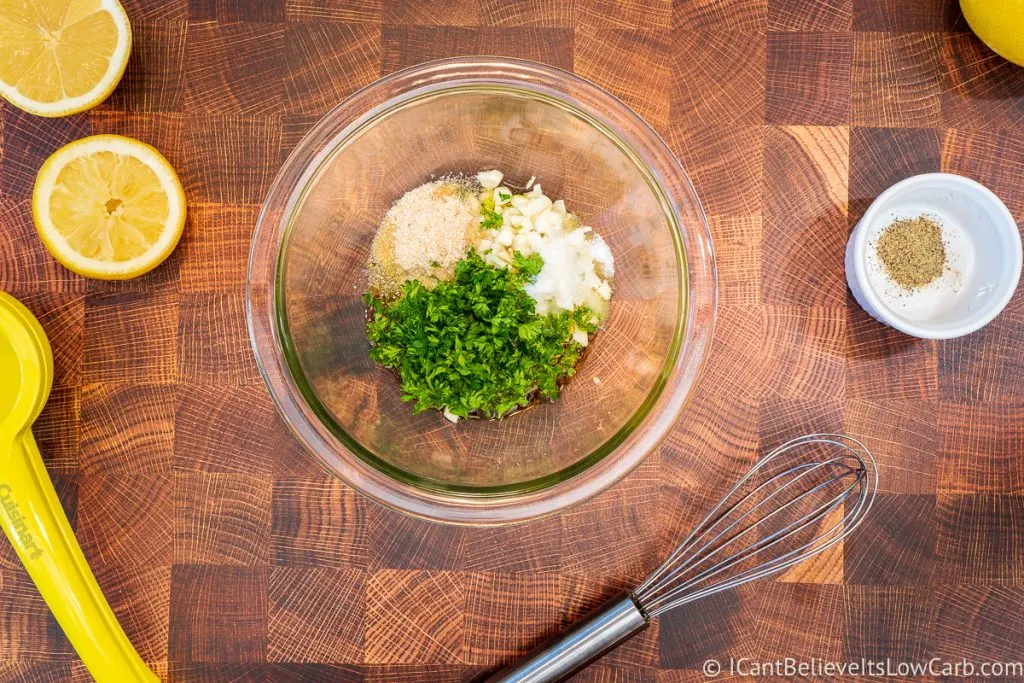
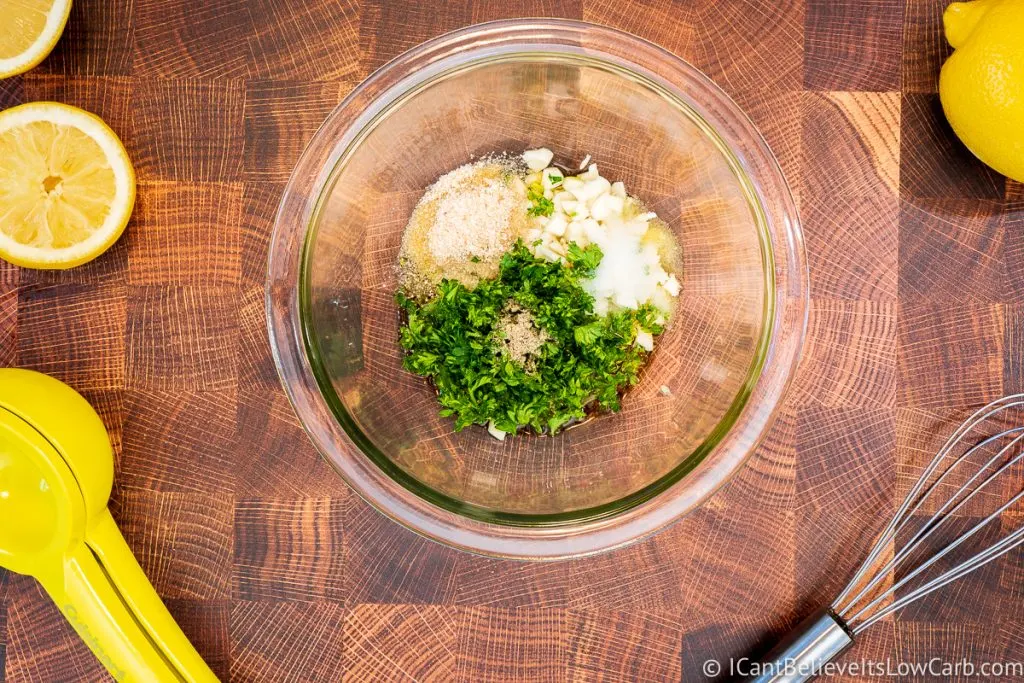
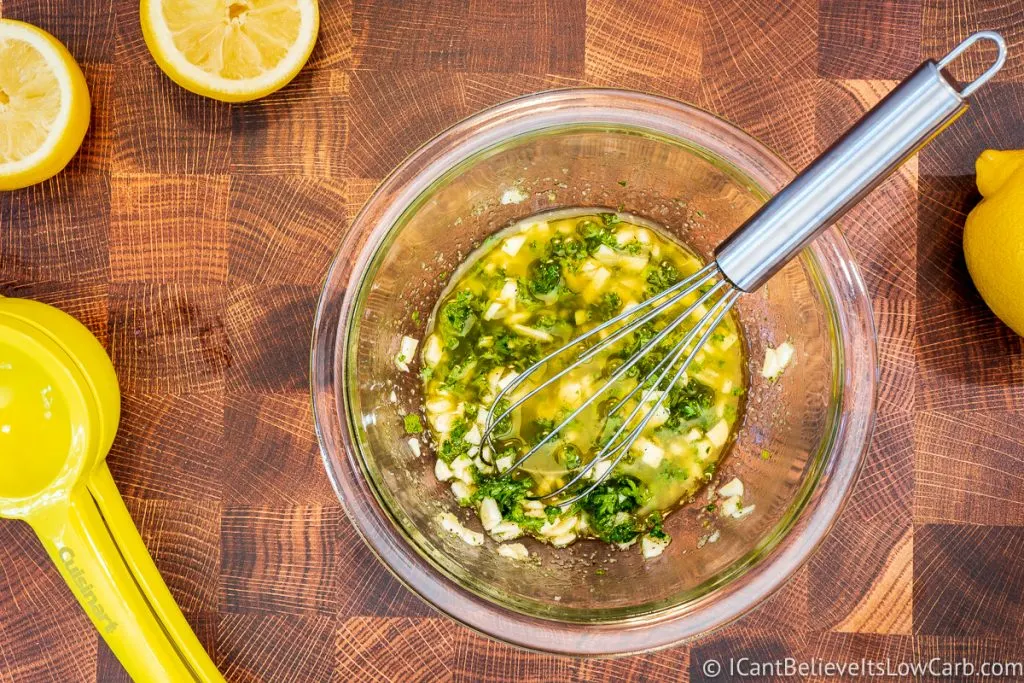
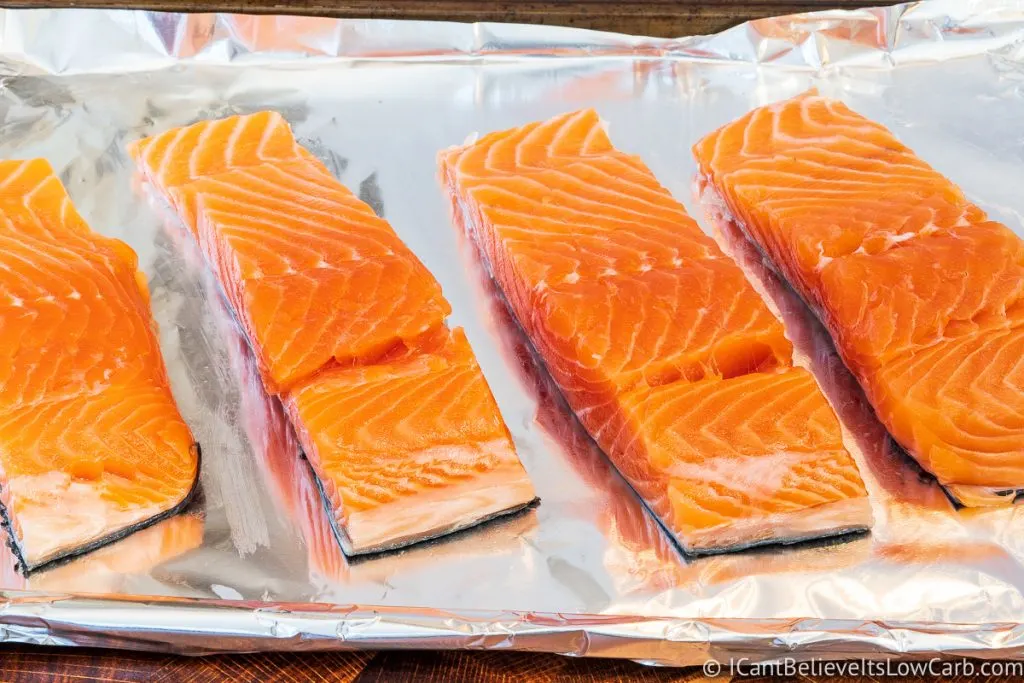
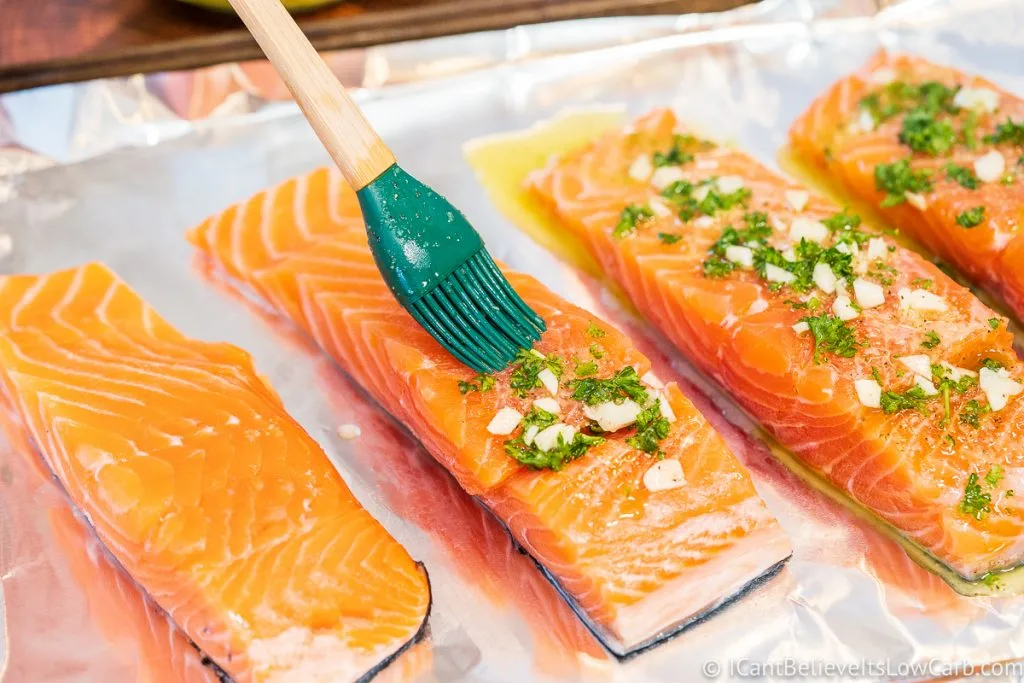
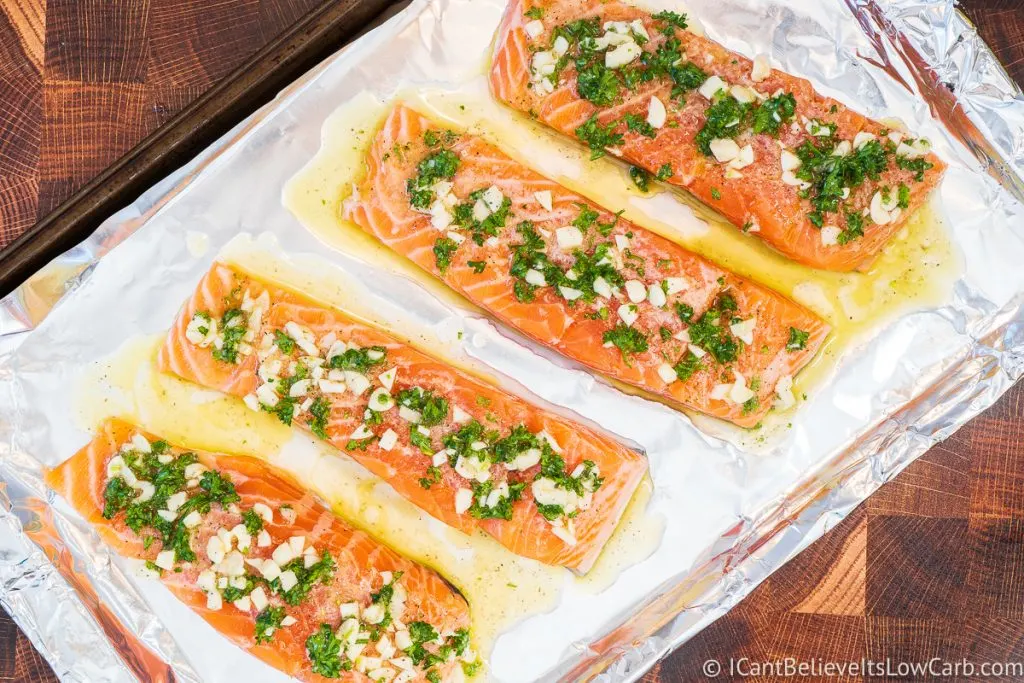
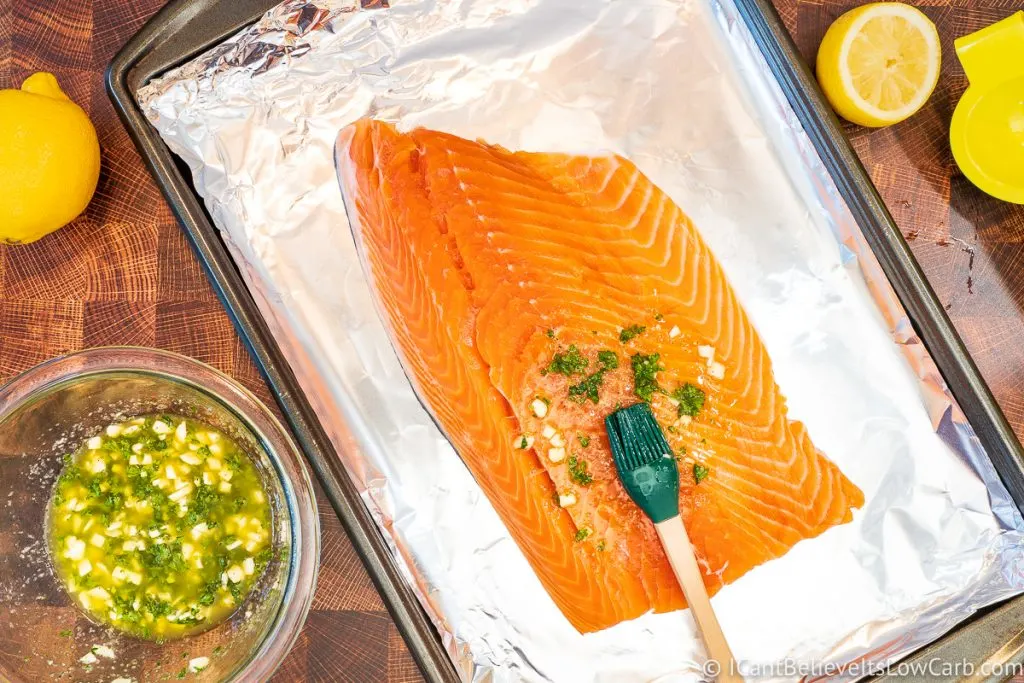


Saturday 2nd of November 2024
Debbie
Sunday 30th of January 2022
This is awesome recipe & very easy
Leigh Oskwarek
Sunday 30th of January 2022
Debbie, Enjoy the salmon!!